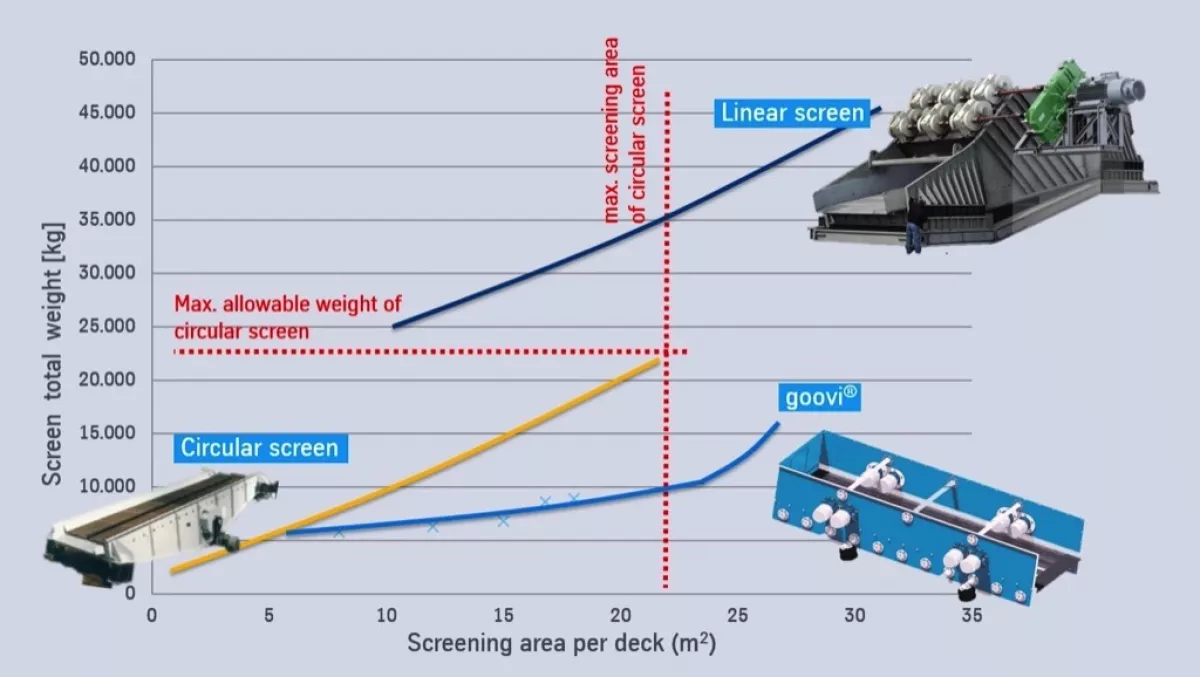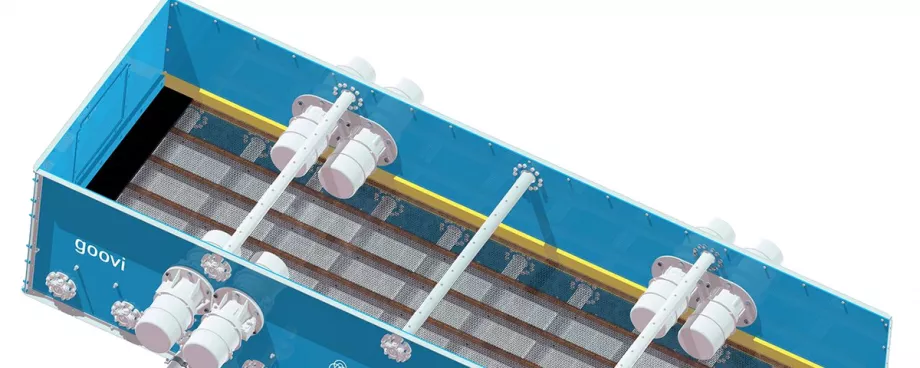2.2 Screen Tray
For the screen tray, too, the priority was a simple, but stable design, which is also easy to assemble. The sidewalls consist of standard sheets that can be fabricated in any size and quality in a laser-cutting process. In the lower section, they are connected by numerous cross beams (Fig. 3) consisting of standard tubes protected against wear with a polyurethane sleeve. In the upper section, just a few cross beams of the same type are sufficient to stabilize the screen tray. This bolted and clamped structure endows the screen tray with high durability. This effect is reinforced by the optimized position of the unbalance motors, which reduces the dynamic load in the sidewalls.
Moreover, the arrangement of the drives leads to a flat design of the goovi® and enables easy installation in existing plants. It is basically possible to assemble the goovi® at the installation site on account of its simple design and, in certain circumstances, this is even recommended as fully assembled screens do have a relatively large volume, which can make their transport expensive. With delivery of a compact construction kit, transport costs can be reduced substantially. In the case of particularly confined spaces, thanks to its very simple design and assembly, the goovi® can be directly assembled in its intended position in the plant. Naturally, provision has been made to comply with the new requirements in the recently revised EN 1009 concerning the space required for maintenance of machinery for the mechanical processing of minerals.
2.3 Screen Decks
The goovi® is supplied with one or two screen decks. For these, a large number of screen surfaces and linings are available, which can consist of wire mesh, rubber or polyurethane as well as a combination of these. The screen has been designed for fitting common standard-size screen panels, which can be quickly and easily changed with little effort.
2.4 Screen Support
For the support of the screen tray, thyssenkrupp has also blazed a new trail. Unlike conventional screens, the goovi® is not suspended on steel or rubber springs, but on air springs with variable pressure, which are fixed to extended cross beams in the lower part of the screen tray (Fig. 3). These offer some notable functional advantages.
For assembly, the screen is first placed on top of four rubber buffers (Fig. 3) before the air springs are inflated. With slight variation of the pressure in the air springs, the goovi® can be optimally adjusted in height and the vibrating performance can be optimized. On account of the lower spring constant compared to steel or rubber springs, the dynamic foundation loads can be reduced significantly, which has a positive effect on the weight of the substructure. Another interesting aspect is the considerable reduction in the noise generated by this type of spring compared to conventional systems.
2.5 Control System
As described earlier, the control system of the fully digitalized goovi® plays an important role. This is used to synchronize the motors and adjust the mode of vibration, the conveying speed and direction, in order to optimally adapt the machine to the application, especially for handling difficult-to-screen feed and changing material properties. The goovi® is supplied with a complete switch cabinet; this is equipped with a touchscreen on which the operator can select different recipes (Fig. 5).

The recipes are configured either on site by thyssenkrupp service operatives or by means of teleservice. Other information, e. g. motor data or vibration monitoring, can be logged and, if necessary, evaluated by means of teleservice.
2.6 Model Range
Following the development of a prototype and successful commissioning of the first goovi® in a steelworks in Germany, thyssenkrupp has developed a standard model range, which is geared to the market requirements and reduces the cost and delivery times. The single- and double-deck variants are available in six different widths and four different lengths, with screening areas between 11 m² and 26.4 m² (Table 2).
| Screening Area | 11 m2 to 26.4 m2 |
|---|---|
| Number of Screen Decks | Single Deck & Double Deck |
| Widths available | 1.8 m, 2.1 m, 2.4 m, 2.7 m, 3.0 m, 3.3 m |
| Lengths available | 5 m, 6 m, 7 m, 8 m |
| Screen Linings | Wire Mesh, Rubber, PU |
| Inclination | variable |
| Screen Support | Air Springs with variable Pressure |
| Total Weight | 5,500 kg to 17,000 kg |
| Total Height | 1.2 m to 1.8 m |
Besides these standard screens, thanks to simple, modular design, individual, customized screens can also be supplied. For example, screening areas can be adapted to specific applications or the sidewall geometries and spring positions can be matched to the available space at a customer’s plant.
Particularly interesting is a comparison of the weights of the goovi® with the weights of conventional screen models (Fig. 6). Here, the advantages of the new screen design are clearly shown. While the linear-motion vibrating screen has, as expected, a very high specific weight relative to the screening area, the goovi® weighs in well below the relatively lightweight circular-motion vibrating screen. Especially for relatively large screening areas, the goovi® weighs less than a half the weight of circular-motion vibrating screens. This trend also applies to the costs and is intensified thanks to the simple design and the small number of driven components.

3. Conclusion
With the overall design and many detail solutions, thyssenkrupp has developed a concept, which can certainly be described as revolutionary. Substantially reduced weights and heights are accompanied by a considerable increase in operational flexibility, product quality and performance, as a result of which the goovi® creates real added value.
The detail features of the goovi® can be summarized as follows:
- Possible applications in almost all secondary and tertiary screening stages
- Simple, modular design, low height and low weight
- Few rotating parts, simple maintenance, no lubrication needed
- Low-cost transport as a construction kit and simple assembly at the installation site are possible
- Ideal for replacing existing screens due to good adaptability to existing plants
- Fully digitalized screen with its own control system for integration into distributed control systems
- Optional, infinite adjustment as a circular-, linear- or elliptical-motion vibrating screen
- Customized, pre-set recipes for different product grades
- Flexible adaption to changing applications and material properties
- Various possibilities for integration into control loops
- High, adjustable screening efficiency, even for handling difficult-to-screen materials
- Less prone to pegging of particles thanks to cleaning function
- High throughput with reduced energy consumption
- Standard series for optimization of costs and lead times
In the meantime, the first goovi® has been in operation for several months and has proven optimally efficient for screening slag (Fig. 2). For different material properties, the screen is run with different settings and achieves the best results for the operator.
■



















